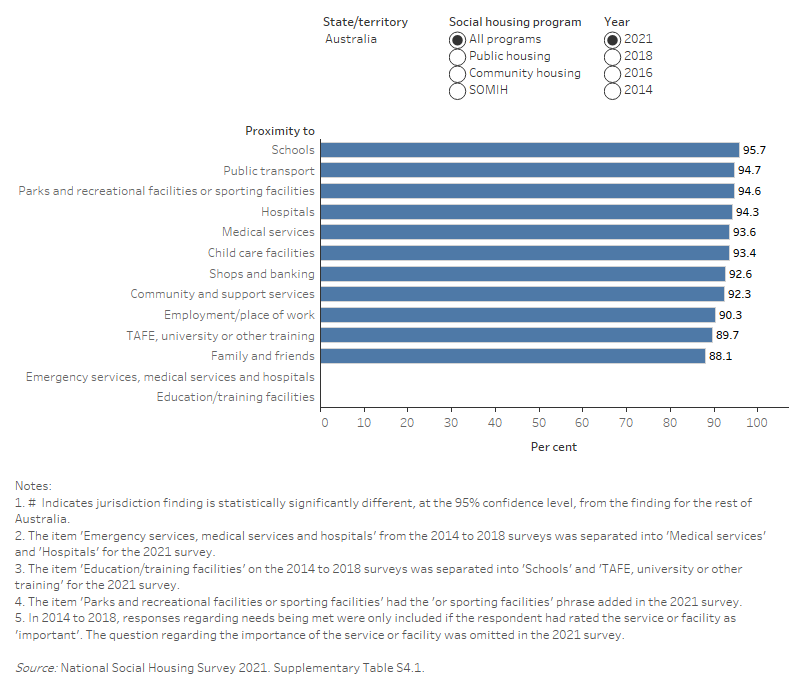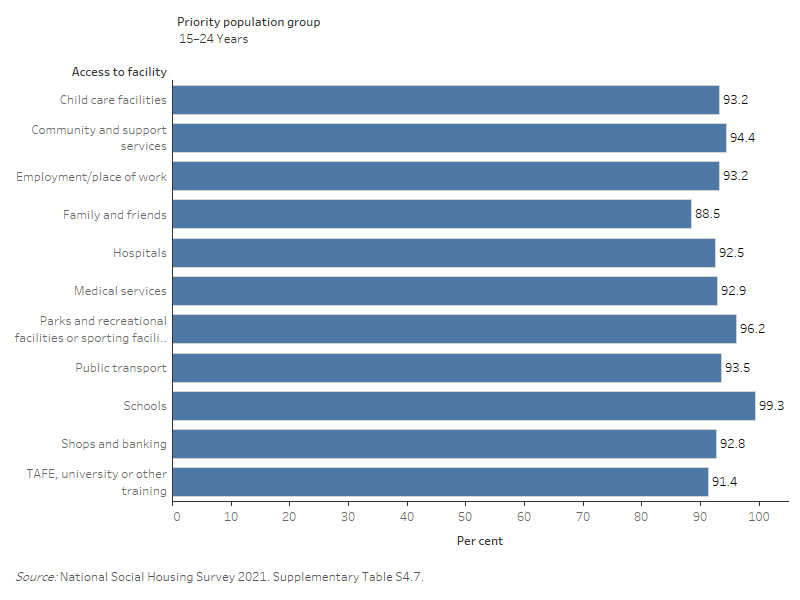Did the location of a tenant’s home meet their needs?
Where people live can have far-reaching implications to their health, and the quality of life they may enjoy (Paddison 2012). It can affect whom they can socialise with, where they can work, what schools they can attend, and which services they can reasonably access (Ong et al. 2022; Paddison 2012; Phibbs and Thompson 2011). As such, it is often a critical factor in people’s housing choice, as the impacts to health and wellbeing can be substantial.
The limited number of available dwellings in specific locations and social housing allocation policies can limit social housing location choice when housing is offered to tenants on the waiting list (Flanagan et al. 2020). Because of this, it is critical to explore whether tenants’ homes meet their location related needs, such as access to education and training facilities, employment and friends and family.
NSHS question about whether location of home meets tenants’ needs
Information about whether the location of a tenant’s home meets their needs was obtained from responses to the following question:
For each of the following access to services, are your needs met in your current home (including the needs of those who live with you)?
Respondents were asked to respond for a list of facilities and services.
'We are very happy to live where we are, as we can walk to all the shops, post office, café.'
'Close to friends, community support, job, church, services for my children.'
'I'm only 10 minutes from the hospital, city centre, library, parks, and shops, public transport is fantastic, and there are a great selection of venues I can go to with family and friends.'
In 2021, nearly all public and community housing tenants reported at least one of their location-related needs were met. Of the needs surveyed, access to:
- schools (96%)
- public transport (95%)
- parks and recreational facilities or sporting facilities (95%)
were the most commonly reported location needs met among public housing tenants ( Figure Location.1, Table S4.1). Among community housing tenants, access to:
- hospitals (94%)
- schools (94%)
- public transport (94%)
- parks and recreational facilities or sporting facilities (94%)
- medical services (94%)
were the most common location-related needs met.
Satisfaction with access to:
- hospitals (95%)
- shops and banking (95%)
- schools (95%)
- medical services (95%)
was also high among SOMIH tenants nationally, however, there was some variation between state and territory results.
Figure Location.1: Satisfaction (%) with location (proximity to facilities and services), by social housing program, states and territories, 2014 to 2021
This interactive horizontal bar graph shows the satisfaction of tenants with their access to facilities and services, within each of the social housing programs over time.

The location-related needs of priority populations can differ compared with other households. For example, access to health services may be important for tenants with specific disability needs.
In 2021 (Figure Location.2, Table S4.7) among tenants of all social housing programs:
- Households with a person living with disability were less likely to report that the location of their dwelling met their needs than others. For example, a lower proportion of tenants in households with a person living with disability reported that their dwelling met their needs for access to:
- community and support services (86% compared with 95% for other households)
- and medical services (89% compared with 95%).
- Except for public transport, tenants that recently experienced homelessness (that is, in the last 5 years) reported less often that their needs were met by the location of their current home than other households; access to family and friends (83%) was the least location-related need met.
- The needs met by the location of the home were mostly similar between Indigenous households and non-Indigenous households. However, a lower proportion of Indigenous tenants reported that their homes provided access to:
- family and friends
- childcare facilities
- employment/place of work and TAFE
- university or other training
compared with other households.
Figure Location.2: Satisfaction (%) with location (proximity to facilities and services), by priority population groups, 2021
This interactive horizontal bar graph shows the satisfaction of tenants with their access to facilities and services, for the priority population groups.

Flanagan K, Levin I, Tually S, Varadharajan M, Verdouw J, Faulkner D, Meltzer A and Vreugdenhil A (2020) ‘Understanding the experience of social housing pathways’, AHURI Final Report No. 231, Australian Housing and Urban Research Institute (AHURI), Melbourne.
Ong R, Singh R, Baker E, Bentley R and Hewton J (2022) ‘Precarious housing and wellbeing: a multidimensional investigation’, AHURI Final Report No. 373, AHURI, Melbourne.
Paddison R (2012) ‘Housing and neighbourhood quality: Urban Regeneration’, International Encyclopedia of Housing and Home: 288-293.
Phibbs P and Thompson S (2011) ‘The health impacts of housing: toward a policy-relevant research agenda’, AHURI Final Report No. 173, AHURI, Melbourne.


